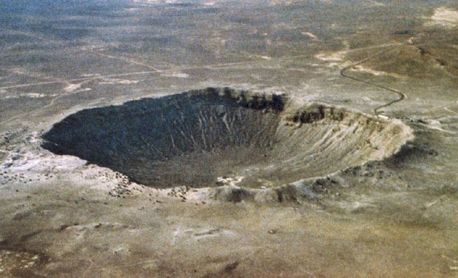Emergence of life
Meteoroids - Sources of life
 |
Barringer Meteorite Crater in Arizona
Twenty years ago scientists simulated the impact of an extraterrestrial rock onto solid ground and found that simple molecules were able to form. However they could not find complex bio substances. Now Yoshihiro Furukawa from Tohoku University in Japan and his team simulated the impact with an ocean. To achieve this they mixed substances, like carbon, iron and nickel, which are found in most meteoroids. Other substances like water, liquid ammonia and nitrogen were added, to account for the substances in the ocean. The scientists then fired a special gun at the mix (reaching a velocity of 2 kilometers per second), to simulate the impact of a meteoroid.
For a very short time, about 0.7 microseconds, the mix was heated up to 5,000 Degrees Kelvin, almost as hot as the photosphere of the sun. A pressure of up to six gigapascal was reached, that is around 60,000 times more than the atmospheric pressure at sea level. When the scientists analyzed the sample they actually found very complex molecules like simple amino acids. Due to the high temperatures the ingredients of the sample were broken down and ionized and as the sample cooled the ingredients assembled into new molecules. The difference to the previous land experiement and this one was the presence of water – a crucial element to bio substances.
The result of this experiment forms an interesting new theory on the emergence of life on our planet. In reality even higher temperatures were reached from meteoroid impact, speading along the formation of more substances, so the scientists argue. As impacts were more common in ancient times an abundance of more complicated substances could have emerged. The impacts of meteoroids on the ancient waters may actually be responsible for life on earth.
Furukawa, Y. et al.: Biomolecule formation by oceanic impacts on early Earth. In: Nature Geoscience 10.1038/ngeo383, 2008
Jan Hattenbach is a journalist in Aachen, Germany
Emergence of life
Meteoroids - Sources of life
 |
Barringer Meteorite Crater in Arizona
Twenty years ago scientists simulated the impact of an extraterrestrial rock onto solid ground and found that simple molecules were able to form. However they could not find complex bio substances. Now Yoshihiro Furukawa from Tohoku University in Japan and his team simulated the impact with an ocean. To achieve this they mixed substances, like carbon, iron and nickel, which are found in most meteoroids. Other substances like water, liquid ammonia and nitrogen were added, to account for the substances in the ocean. The scientists then fired a special gun at the mix (reaching a velocity of 2 kilometers per second), to simulate the impact of a meteoroid.
For a very short time, about 0.7 microseconds, the mix was heated up to 5,000 Degrees Kelvin, almost as hot as the photosphere of the sun. A pressure of up to six gigapascal was reached, that is around 60,000 times more than the atmospheric pressure at sea level. When the scientists analyzed the sample they actually found very complex molecules like simple amino acids. Due to the high temperatures the ingredients of the sample were broken down and ionized and as the sample cooled the ingredients assembled into new molecules. The difference to the previous land experiement and this one was the presence of water – a crucial element to bio substances.
The result of this experiment forms an interesting new theory on the emergence of life on our planet. In reality even higher temperatures were reached from meteoroid impact, speading along the formation of more substances, so the scientists argue. As impacts were more common in ancient times an abundance of more complicated substances could have emerged. The impacts of meteoroids on the ancient waters may actually be responsible for life on earth.
Furukawa, Y. et al.: Biomolecule formation by oceanic impacts on early Earth. In: Nature Geoscience 10.1038/ngeo383, 2008
Jan Hattenbach is a journalist in Aachen, Germany






